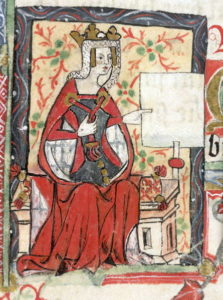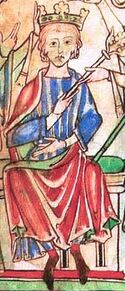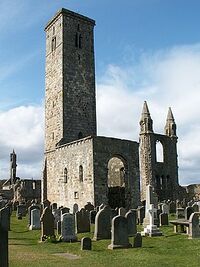Lulach the Bold
| Lulach II | |
|---|---|
 Lulach in a charter of 1145 | |
| King of Scots | |
| Reign | 17 November 1122 - 26 July 1146 |
| Predecessor | Malsnectan |
| Successor | Kenneth IV |
| Born | 8 April 1074 Scotland |
| Died | 26 July 1146 (aged 72) St. Andrews, Scotland |
| Burial | Dunfermline Abbey |
| Consort | Trude Salian (m. 1095; d. 1107) Sigrid, princess of Denmark (m. 1112) |
| Issue | Ragnall, duke of Mann
Donald |
| House | of Moray |
| Father | Malsnectan |
| Mother | Cecelia of Normandy |
Lulach II, known as Lulach the Bold (8 April 1074 - 26 July 1146) reigned as King of Scots from 1122 until his death. The second king of the Moray dynasty, Lulach expanded Scottish power deep into England, exploiting the internal chaos experienced by the southern realm during his reign to conquer most of ancient Northumbria and parts of western England. An accomplished warrior and commander of men, he derived his epithet from his invasion of England in 1123-24.
Towards the end of his reign, Lulach was faced with the murder of his son and designated heir Ragnall in 1139, and the subsequent rebellion of his grandson Constantine, aided by the king of England. Lulach defeated this challenge, and on his death in 1146 he was succeeded by his only surviving brother Kenneth; Lulach's third son Hugh later became king.
Early life
Lulach was born on 8 April 1074, possibly at his father's stronghold of Forres in Moray, the eldest son and child of Malsnectan, king of Scots, and his wife Cecelia of Normandy, a daughter of William the Bastard, duke of Normandy. Little is known of his childhood, but from birth he was probably recognized as the future king; his position as heir was strengthened by his father's extermination of the rival Dunkeld dynasty in 1080-84. In 1086, when Lulach was twelve, his father forced the nobility and clergy to swear oaths of support for his eventual accession.
In the 1090s Lulach was a young knight in the Norman tradition of his mother, joining his father on his campaign in Caithness at the beginning of the decade. Initially proposed as the groom of Isabelle Capet, daughter of Philip, king of France, and then as the husband of Margrete, countess of Caithness, Lulach ultimately married Trude Salian, daughter of Henry IV, Holy Roman Emperor, in 1095, in a wedding long remembered in the northern regions of Britain for its splendor. In 1097 Lulach led a large war-band during his father's invasion of England, and joined him in capturing York the following year.
Adult prince
In a story repeated frequently by later chroniclers, Lulach celebrated Christmas of 1098 at the king's court in Carlisle with his uncle Erik Svendsen. Lulach and Erik competed for the king's favor, symbolized by taking possession of the royal spear to kill a boar for the feast. Malsnectan gave the spear to Erik, who was gored and fatally injured by the boar later that afternoon. In the aftermath of his lucky escape, Lulach founded a chapel at Carlisle in honor of the Virgin Mary.
In 1102, Lulach murdered Eudes de Bourgogne, prince of France, a friend and counselor of his father, after a verbal argument while the king's court was at Forres. According to one chronicler, Lulach struck Eudes down with his sword and the prince's companions rushed to his aid, bashing Eudes' brains out and leaving him lifeless in the courtyard of the castle. Lulach escaped punishment for the murder, perhaps because the death of his mother Queen Cecelia later that year overshadowed the killing.
Lulach's first wife Trude died in 1107 after giving birth to her fourth child and was buried at Dunfermline Abbey. Lulach was grief-stricken by her death and did not take a new wife until 1112, when he married the Danish princess Sigrid after negotiations between Scotland and Denmark. In 1115 Lulach, now in his early forties and at the peak of his powers as a warrior, bypassed his elderly father's authority to raise a Scottish host and invade England. Lulach was defeated at St. Aidan's on 31 July 1115, after which Malsnectan resumed control of Scottish diplomacy and brought the war to an end. In 1116 Lulach's eldest son Ragnall married Ủna ua Cheinnselaig, countess of Meath and Dublin, and he travelled to Ireland for the wedding.
Lulach's influence grew apace as Malsnectan aged. By the early 1120s the old king was carried around in a litter, while Lulach was probably the supreme power in the kingdom. Malsnectan died at Perth on 17 November 1122.
Reign (1122-46)
Lulach was inaugurated as king of Scots at Scone on 18 November 1122, at the age of forty-eight. Several days after his inauguration he was almost killed by a bear while hunting in the Carse of Gowrie. The beginning of Lulach's reign in Scotland coincided with a new phase in the ongoing civil war in England. The deposition of Astrid, queen of England, in 1117 had not gone unchallenged, and the resulting four years of political conflict resulted in the election of Kentigern of Strathearn, a Scot, to the English throne in 1121, a compromise that pleased nobody. In March 1123 Astrid secured a second coronation at Westminster after her partisans attacked London and slaughtered Kentigern's supporters in the city.
Kentigern refused to give up the throne and established himself as rival king at Hertford, splitting England into two parts, with the Midlands and the important city of Winchester supporting Kentigern and most of the southast, along with Northamptonshire and Middlesex, supporting Astrid. Meanwhile Godwine, earl of Northumberland, proclaimed himself king of Northumbria and renounced his allegiance to the English crown. Later in 1123 Thurfrith, earl of Derby and Chester, rebelled against Kentigern and established an independent kingdom of Mercia.
Conquest of Northumbria
The disintegration of the kingdom of England provided Lulach with miraculous opportunities for plunder and expansion. In the summer of 1123 the Scottish king led an invasion of Northumbria and defeated Godwine of Northumbria's army at Furness. Towards the end of the year Lulach captured the rich town of Durham, burning it to the ground, before besieging the castle of Bamburgh; the port town of Hartlepool was also destroyed by the Scots. When Godwine cautiously approached with a force of knights to relieve the castle, Lulach rounded on him and routed his men.
In early 1124 Lulach summoned Godwine to Edinburgh, recently risen to importance under the lordship of Edward Dunbar, and forced him to do homage as "duke of Northumbria", annexing his lands to the Scottish crown as a feudal vassal. Meanwhile the chaos in England continued; later that year, Queen Astrid agreed to ally with Thurfrith, king of Mercia, recognizing his independence in exchange for a mutual attack on Kenitgern of Strathearn. After a hunting injury in the autumn of 1124, Lulach summoned his vassals to Dunfermline in May 1125 and made them swear oaths to his eldest son Ragnall as the next king.
Conquest of Chester
One nobleman who refused to swear allegiance to Ragnall was Æthelwine, the Anglo-Saxon earl of Teviotdale, who was already feuding with his lord Edward Dunbar. In 1126 Lulach brought an army to Teviotdale and forced Æthelwine to flee over the border into Mercia, leaving the province in the hands of Edward Dunbar before continuing south. Lulach intended to attack Thurfrith of Mercia, taking advantage of his preoccupation with the war against Kentigern, but was forced to retire to Carlisle in the late spring by an aggravation of his hunting injury. Ragnall mac Lulach took command of the Scottish host, and chased Thurfrith out of Yoredale after a "bloody combat" in August.
By January 1127 Ragnall had captured Chester, a prominent town in western England, in a severe blow to Thurfrith. The stone walls of the town were garrisoned by paid mercenaries and Ragnall brought his army to face Thurfrith at Scarborough. In the ensuing battle many Mercians were slain and a group of Danish warriors sent by Ulf Svendsen, king of Denmark, captured Thurfrith alive on the field. In March Lulach travelled south to York to accept Thurfrith's surrender. In exchange for his release, the Mercian king was forced to surrender Chester to the Scots in perpetuity.
Domestic affairs
In 1124 Lulach ordered the arrest of Rory son of Somerled, earl of Fife, for unspecified reasons, committing the earldom to Ronald, bishop of St. Andrews. The king and the earl seemingly reconciled, but in 1127 Rory raised his banner in open revolt against Lulach and was joined by his father-in-law Matad, earl of Buchan. Ragnall mac Lulach invaded Fife with an army and defeated the earl's warriors in battle before laying siege to the stone tower at Cupar. In October 1127 Ragnall defeated Matad of Buchan at Dunblane, ending the rebellion.
In the aftermath of the 1127 rebellion Lulach pardoned Matad of Buchan in recognition of his past services, but ordered Rory of Fife to be executed. Lulach installed Matad of Argyll, a cousin of Fergus, earl of Argyll, as earl of Fife. In early 1128 Lulach visited Argyll and forced Fergus to pay a sum of gold, claiming that he cut the throat of the king's messenger bringing news of his cousin's elevation. Later that year Matad of Buchan raised a second rebellion. Lulach rode north in person with an army, capturing Ellon on 26 September 1128 and destroying its stone keep.
After capturing the rebellious earl, Lulach ordered Matad's execution at Aberdeen in January 1129 to underline his authority. After the violent deaths of the earls of Fife and Buchan, peace descended over Scotland. In 1131 Lulach gave his eldest son the titles of "duke" of Mann and earl of Lancaster to secure his position as heir; the following year, according to several chroniclers, Ragnall ruled the kingdom for several months while Lulach secluded himself in prayer and meditation. In 1133 Lulach made a pilgrimage to the shrine of St. James at Santiago in the Spanish kingdom of Galicia, leaving Ragnall as guardian of Scotland until his return.
Despite Lulach's troubled relationship with Fergus, earl of Argyll, the king was enraged when the earl was murdered at Dunstaffnage by his own son Fingal in November 1135. Lulach captured Dunstaffnage in March 1136, burned the wooden to castle to ashes, and ordered Fingal's neck to be broken. Over the course of the next year hostilities rose between Lulach and Thurfrith, king of Mercia, who demanded the return of Chester; the growing tension culminated in the battle of Halton on 27 May 1137, where the Scottish king led an army to slaughter the Mercians. Lulach returned to Dunfermline after the battle, leaving Ragnall to conduct a military campaign that resulted in the Mercian surrender of Yoredale to the Scots at the end of the year.
In 1138 the aged king was troubled by the visit of his grandson Constantine mac Ragnall, firstborn son of the duke of Mann, to the court of Ragnvald, king of England. In the same year Glasgow rebelled against Lulach's authority, and according to several chroniclers he ordered the town to be burned to the ground, inflicting a devastation from which it took years to recover.
Succession crisis
On 9 May 1139 Lulach's eldest son Ragnall, duke of Mann and earl of Lancaster, was killed in Linlithgow by "vile persons", as the Book of Deer describes them. According to the traditional story, the prince was fatally stabbed by a townsman during a confrontation with an angry mob, as his stewards were attempting to drive his cattle through the main street on market-day. Ragnall's death sparked a succession crisis in Scotland, as his son and heir Constantine had been raised in Ireland and was unacceptable to many Scotitsh noblemen. In opposition to Constantine, Lulach's brother Kenneth and the king's eldest living son Hugh both raised claims to the throne.
In August 1139, Lulach assuaged the political tension by nominating Kenneth and Hugh as successive heirs to the throne. In response to his disinheritance, Constantine renounced his allegiance to his grandfather. A bloodless conflict ensued until Lulach received his grandson at Lanark sometime in 1140 and forced him to pay a huge sum in exchange for a pardon. Constantine fled to his maternal Irish lands after this confrontation and began to plot a more serious uprising, which began in early 1141. The burgeoning rebellion turned into a crisis when the king of England agreed to aid Constantine in his war against Lulach.
Lulach proved himself his father's son in the ensuing war; he led an army of 10,000 men to his grandson's stronghold at Lancaster and overcame its garrison in a risky night attack, before defeating an army of Manxmen and Irishmen at Macclesfield on 29 October. In 1142 Lulach launched a naval attack on the Isle of Man, wasting the entire island and slaughtering many of its inhabitants. Meanwhile Ragnvald, king of England, invaded Northumbria and defeated the local levies, threatening Scottish control over the region.
Ragnvald attempted to follow up his Northumbrian victory with a daring raid on Argyll, and led a fleet into the Irish Sea for this purpose, but after landing in Ayrshire to plunder for supplies the English king was "captured in an ambush" and brought in chains to Lulach at Dunstaffnage. Ragnvald, who had married Lulach's granddaughter Lorna nic Ragnall, was allowed to go free, but Constantine mac Ragnall was not so lucky; later in 1142 Lulach sailed to Ireland with an armed force and captured his grandson at Forradh, before sending him to prison at the remote castle of Thurso in northern Caithness. In 1143 Constantine was put on trial before the king's justiciars, who formally sentenced him to spend the rest of his life in prison.
Final years
In 1144, after passing his seventieth birthday, Lulach convened an assembly of the nobility and prelacy at Dunblane and took written oaths in support of the succession agreement of 1139, naming Kenneth mac Malsnectan as the immediate heir and Hugh mac Lulach as the next heir. During his later years Lulach engaged in building works at Scone, hiring French stonemasons to help build a new gatehouse, as well as erecting a tall stone tower and wooden palace complex at St. Andrews where he kept a dancing bear.
In his final years Lulach spent most of his time at St. Andrews and gradually withdrew from public view, dying there on 26 July 1146. In a break from tradition, he was buried at Dunfermline Abbey alongside his first wife, while his brother Kenneth was inaugurated as king three days after his death.
Issue
By his first wife Trude Salian, a princess of the Holy Roman Empire (married 1095; died 1107), Lulach had four children:
- Ragnall, duke of Mann (1099 - 9 May 1139), heir apparent until his death.
- Donald (1102 - 1124), a Knight Templar.
- Hugh the Hunter (24 December 1103 - 19 November 1176), king of Scots from 1159 to 1176.
- Barabal (1107 - 1131), married Alfonso, king of Aragon.
By his second wife Sigrid, princess of Denmark (married 1112), Lulach had four more children:
- Harald (1118 - 1166)
- Sigrid (1119 - 1176), married Magne Brusastad, a Danish nobleman.
- Eric the Crusader (1126 - 19 May 1192), crusader king of Egypt from 1185 to 1192.
- Henry (1132 - 1157), crusader duke of Capua.



